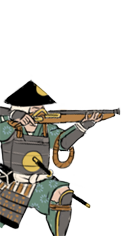
Basic Unit Statistics (can be modified by difficulty level, arts, skills, traits and retainers)
| Recruitment Cost | 250 | |
| Upkeep Cost | 100 | |
| Melee Attack | 2 | 5% |
| Charge Bonus | 2 | 4% |
| Bonus vs Cavalry | 0 | 0% |
| Range | 100 | 15% |
| Accuracy | 35 | 35% |
| Reloading Skill | 15 | 15% |
| Ammunition | 15 | 18% |
| Melee Defence | 1 | 2% |
| Armour | 1 | 6% |
| Morale | 4 | 8% |
Strengths & Weaknesses
- Good range but shorter than bow units.
- Devastating damage.
- Low accuracy, reload rate and morale.
- Very vulnerable to cavalry and in melee.
Abilities
- Bamboo Wall - A large wall that can be erected during the deployment phase. It blocks the movement of enemies and protects against cavalry charges.
- Fire by Rank - Will fire by rank from front to rear, each rank kneeling to reload and allowing those behind a clear field of fire.
Requires
Description
These ashigaru troops are armed with matchlock arquebuses and can pepper the enemy with long range, mass volleys.
The role of matchlock ashigaru is to unleash massed volleys of gunfire upon the enemy, keeping them confused and, in the process, weakening them enough for a frontline charge. Those belonging to the Christian Otomo clan fight with great religious fervour, which increases the accuracy of their fire and enables them to reload at a faster rate than other troops of a similar class. Once fired, matchlock guns take a long time to reload, but their range, noise, and effect on enemy morale more than compensates for this lack of speed. The smoke and fire they produce can be very disorientating to targeted enemies, particularly when men are dropping all around. When the main fighting starts matchlock gunners should retreat behind melee troops. They do not have the training to fight in close combat and have no defence against a cavalry charge. Coming to prominence during the Kamakura Shogunate following the Gempei War, the Otomo clan remained at the forefront of feudal politics for the next four hundred years. Alongside the Shimazu, the Otomo were one of the largest clans on Kyushu, and had early contacts with the Portuguese, soon establishing trade links. Their daimyo, Otomo Sorin, saw the benefits to the clan's prosperity and wanted the emerging gun technology that European trade could bring. Following the arrival of the Jesuit missionary Francis Xavier in 1549, and his subsequent meeting with the daimyo, Otomo Sorin showed tolerance towards the Jesuit conversion of Japanese subjects to Catholicism, eventually converting himself in 1578. During the Sengoku Jidai, the Otomo fought against both the Shimazu and the Mori clans. They retained control of their lands into the Edo Period by playing a minor role during Tokugawa Ieyasu's Sekigahara Campaign.